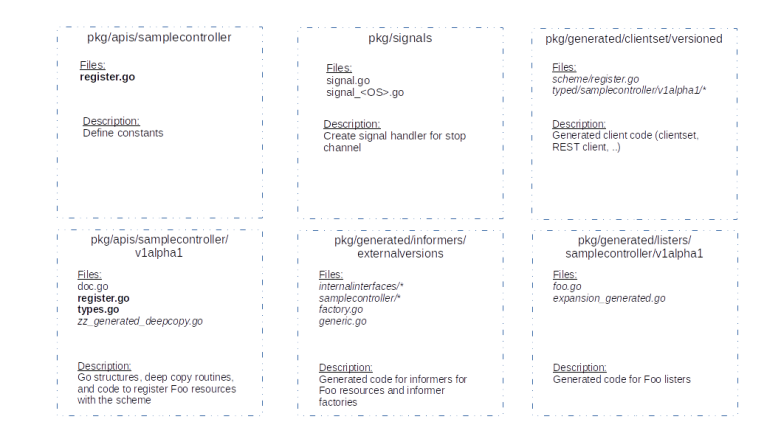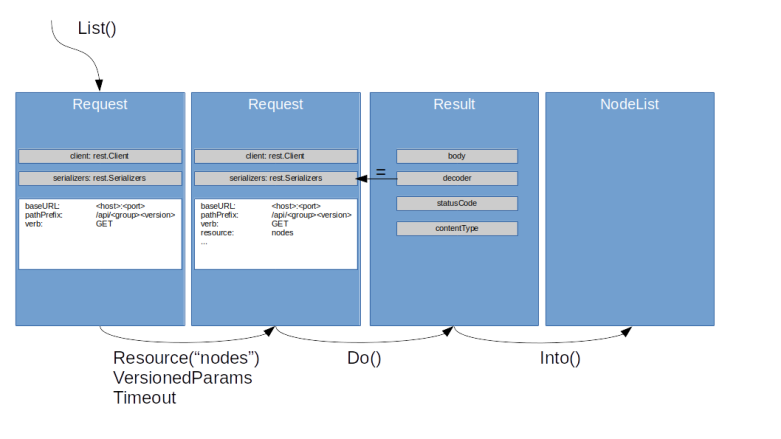In the last post, we have set up our Go development environment and downloaded the Kubernetes Go client package. In this post, we will start to work on our first Go program which will retrieve and display a list of all nodes in a cluster.
You can download the full program here from my GitHub account. Copy this file to a subdirectory of the src directory in your Go workspace. You can build the program with
go build
which will create an executable called example1. If you run this (and have a working kubectl configuration pointing to a cluster with some nodes), you should see an output similar to the following.
$ ./example1
NAME ARCH OS
my-pool-7t62 amd64 Debian GNU/Linux 9 (stretch)
my-pool-7t6p amd64 Debian GNU/Linux 9 (stretch)
Let us now go through the code step by step. In the first few lines, I declare my source code as part of the package main (which Go will search for the main entry point) and import a few packages that we will need later.
package main
import (
"fmt"
"path/filepath"
metav1 "k8s.io/apimachinery/pkg/apis/meta/v1"
"k8s.io/client-go/kubernetes"
"k8s.io/client-go/tools/clientcmd"
"k8s.io/client-go/util/homedir"
)
Note that the first two packages are Go standard packages, whereas the other four are Kubernetes packages. Also note that we import the package k8s.io/apimachinery/pkg/apis/meta/v1 using metav1 as an alias, so that an element foo in this package will be accessible as metav1.foo.
Next, we declare a function called main. As in many other program languages, the linker will use this function (in the package main) as an entry point for the executable.
func main() {
....
}
This function does not take any arguments and has no return values. Note that in Go, the return value is declared after the function name, not in front of the function name as in C or Java. Let us now take a look at the first three lines in the program
home := homedir.HomeDir()
kubeconfig := filepath.Join(home, ".kube", "config")
fmt.Printf("%-20s %-10s %s\n", "NAME", "ARCH", "OS")
In the first line, we declare and initialize (using the := syntax) a variable called home. Variables in Go are strongly typed, but with this short variable declaration syntax, we ask the compiler to derive the type of the variable automatically from the assigned value.
Let us try to figure out this value. homedir is one of the packages that we have imported above. Using go list -json k8s.io/client-go/util/homedir, you can easily find the file in which this package is described. Let us look for a function HomeDir.
$ grep HomeDir $GOPATH/src/k8s.io/client-go/util/homedir/homedir.go
// HomeDir returns the home directory for the current user
func HomeDir() string {
We see that there is a function HomeDir which returns a string, so our variable home will be a string. Note that the name of the function starts with an uppercase character so that it is exported by Go (in Go, elements starting with an uppercase character are exported, elements that start with a lowercase character not – you have to get used to this if you have worked with C or Java before). Applying the same exercise to the second line, you will find that kubeconfig is a string that is built from the three arguments to the function Join in the package filepath and path separators, i.e. this will be the path to the kubectl config file. Finally, the third line prints the header of the table of nodes we want to generate, in a printf-like syntax.
The next few lines in our code use the name of the kubectl config file to apply the configuration.
config, err := clientcmd.BuildConfigFromFlags("", kubeconfig)
if err != nil {
panic(err)
}
This is again relatively straightforward, with one exception. The function BuildConfigFromFlags does actually return two values, as we can also see in its function declaration.
$ (cd $GOPATH/src/k8s.io/client-go/tools/clientcmd ; grep "BuildConfigFromFlags" *.go)
client_config.go:// BuildConfigFromFlags is a helper function that builds configs from a master
client_config.go:func BuildConfigFromFlags(masterUrl, kubeconfigPath string) (*restclient.Config, error) {
client_config_test.go: config, err := BuildConfigFromFlags("", tmpfile.Name())
The first argument is the actual configuration, the second is an error. We store both return values and check the error value – if everything went well, this should be nil which is the null value in Go.
Structures and methods
As a next step, we create a reference to the API client that we will use – a clientset.
clientset, err := kubernetes.NewForConfig(config)
if err != nil {
panic(err)
}
Again, we can easily locate the function that we actually call here and try to determine its return type. By now, you should know how to figure out the directory in which we have to search for the answer.
$ (cd $GOPATH/src/k8s.io/client-go/kubernetes ; grep "func NewForConfig(" *.go)
clientset.go:func NewForConfig(c *rest.Config) (*Clientset, error) {
Now this is interesting for a couple of reasons. First, the first return value is of type *Clientset. This, like in C, is a pointer (yes, there are pointers in Go, but there is no pointer arithmetic), refering to the area in memory where an object is stored. The type of this object Clientset is not an elementary type, but seems to be a custom data type. If you search the file clientset.go in which the function is defined for the string Clientset, you will easy locate its definition.
// Clientset contains the clients for groups. Each group has exactly one
// version included in a Clientset.
type Clientset struct {
*discovery.DiscoveryClient
admissionregistrationV1beta1 *admissionregistrationv1beta1.AdmissionregistrationV1beta1Client
appsV1 *appsv1.AppsV1Client
appsV1beta1 *appsv1beta1.AppsV1beta1Client
...
coreV1 *corev1.CoreV1Client
...
}
where I have removed some lines for better readibility. So this is a structure. Similar to C, a structure is a sequence of named elements (field) which are bundled into one data structure. In the third line, for instance, we declare a field called appsV1 which is a pointer to an object of type appsv1.AppsV1Client (note that appsv1 is a package imported at the start of the file). The first line is a bit different – there is a field type, but not field name. This is called an embedded field, and its name is derived from the type name as the unqualified part of this name (in this case, this would be DiscoveryClient).
The field that we need from this structure is the field coreV1. However, there is a problem. Recall that only fields whose names start with an uppercase character are exported. So from outside the package, we cannot simply access this field using something like
clientset.coreV1
Instead, we need a function that returns this value which is located inside the package, something like a getter function. If you inspect the file clientset.go, you will easily locate the following function
// CoreV1 retrieves the CoreV1Client
func (c *Clientset) CoreV1() corev1.CoreV1Interface {
return c.coreV1
}
This seems to be doing what we need, but its declaration is a bit unusual. There is a function name (CoreV1()), a return type (corev1.CoreV1Interface) and an empty parameter list. But there is also a declaration preceding the function name ((c *Clientset)).
This is called a receiver argument in Go. This binds our function to the type Clientset and at the same time acts as a parameter. When you invoke this function, you do it in the context of an instance of the type Clientset. In our example, we invoke this function as follows.
coreClient := clientset.CoreV1()
Here we call the function CoreV1 that we have just seen in clientset.go, passing a pointer to our instance clientset as the argument c. The function will then get the field coreV1 from this instance (which it can do, as it is located in the same package), and returns its value. Such a function could also accept additional parameters which are passed as usual. Note that the type of the receiver argument and the function need to be defined in the same package, otherwise the compiler would not know in which package it should look for the function CoreV1(). The presence of a receiver field turns a function into a method.
This looks a bit complicated, but is in fact rather intuitive (and those of you who have seen object oriented Perl know the drill). This construction links the structure Clientset containing data and the function CoreV1() with each other, under the umbrella of the package in which data type and function are defined. This comes close to a class in object-oriented programming languages.
Interfaces and inheritance
At this point, we hold the variable coreClient in our hands, and we know that it contains a (pointer to) an instance of the type k8s.io/client-go/kubernetes/typed/core/v1/CoreV1Interface. Resolving packages as before, we can now locate the file in which this type is declared.
$ (cd $GOPATH/src/k8s.io/client-go/kubernetes/typed/core/v1 ; grep "type CoreV1Interface" *.go)
core_client.go:type CoreV1Interface interface {
Hmm..this does not look like a structure. In fact, this is an interface. An interface defines a collection of methods (not just ordinary functions!). The value of an interface can be an instance of any type which implements all these methods, i.e. a type to which methods with the same names and signatures as those contained in the interface are linked using receiver arguments.
This sounds complicated, so let us look at a simple example from the corresponding section of “Tour in Go”.
type I interface {
M()
}
type T struct {
S string
}
// This method means type T implements the interface I,
// but we don't need to explicitly declare that it does so.
func (t T) M() {
fmt.Println(t.S)
}
Here T is a structure containing a field S. The function M() has a receiver argument of type T and is therefore a method linked to the structure T. The interface I can be “anything on which we can call a method M“. Hence any variable to type T would be an admissible value for a variable of type I. In this sense, T implements I. Note that the “implements” relation is purely implicit, there is no declaration of implementation like in Java.
Let us now try to understand what this means in our case. If you locate the definition of the interface CoreV1Interface in core_client.go, you will see something like
type CoreV1Interface interface {
RESTClient() rest.Interface
ComponentStatusesGetter
ConfigMapsGetter
...
NodesGetter
...
}
The first line looks as expected – the interface contains a method RESTClient() returning a k8s.io/client-go/rest/Interface. However, the following lines do not look like method definitions. In fact, if you search the source code for these names, you will find that these are again interfaces! ConfigMapsGetter, for instance, is an interface declared in configmap.go which belongs to the same package and is defined as follows.
// ConfigMapsGetter has a method to return a ConfigMapInterface.
// A group's client should implement this interface.
type ConfigMapsGetter interface {
ConfigMaps(namespace string) ConfigMapInterface
}
So this is a “real” interface. Its occurence in CoreV1Interface is an example of an embedded interface. This simply means that the interface CoreV1Interface contains all methods declared in ConfigMapsGetter plus all the other methods declared directly. This relation corresponds to interface inheritance in Java.
Among other interfaces, we find that CoreV1Interface embeds (think: inherits) the interface NodesGetter. Surprisingly, this is defined in node.go.
type NodesGetter interface {
Nodes() NodeInterface
}
So we find that our variable coreClient contains something that – among other interfaces – implements the NodeGetter interface and therefore has a method called Nodes(). Thus we could do something like
coreClient.Nodes()
which would return an instance of the interface type NodeInterface. This in turn is declared in the same file, and we find that it has a method List()
type NodeInterface interface {
Create(*v1.Node) (*v1.Node, error)
... List(opts metav1.ListOptions) (*v1.NodeList, error)
...
}
This will return two things – an instance of NodeList and an error. NodeList is part of the package k8s.io/api/core/v1 and declared in types.go. To get this node list, we therefore need the following code.
nodeList, err := coreClient.Nodes().List(metav1.ListOptions{})
Note the argument to List – this is an anonymous instance of the type ListOptions which is just a structure, here we create an instance of this structure with all fields being nil and pass that instance as a parameter.
This completes our post for today. We have learned to navigate through structures, interfaces, methods and inheritance and how to locate type definitions and method signatures in the source code. In the next post, we will learn how to work with the node list, i.e. how to walk the list and prints its contents.










